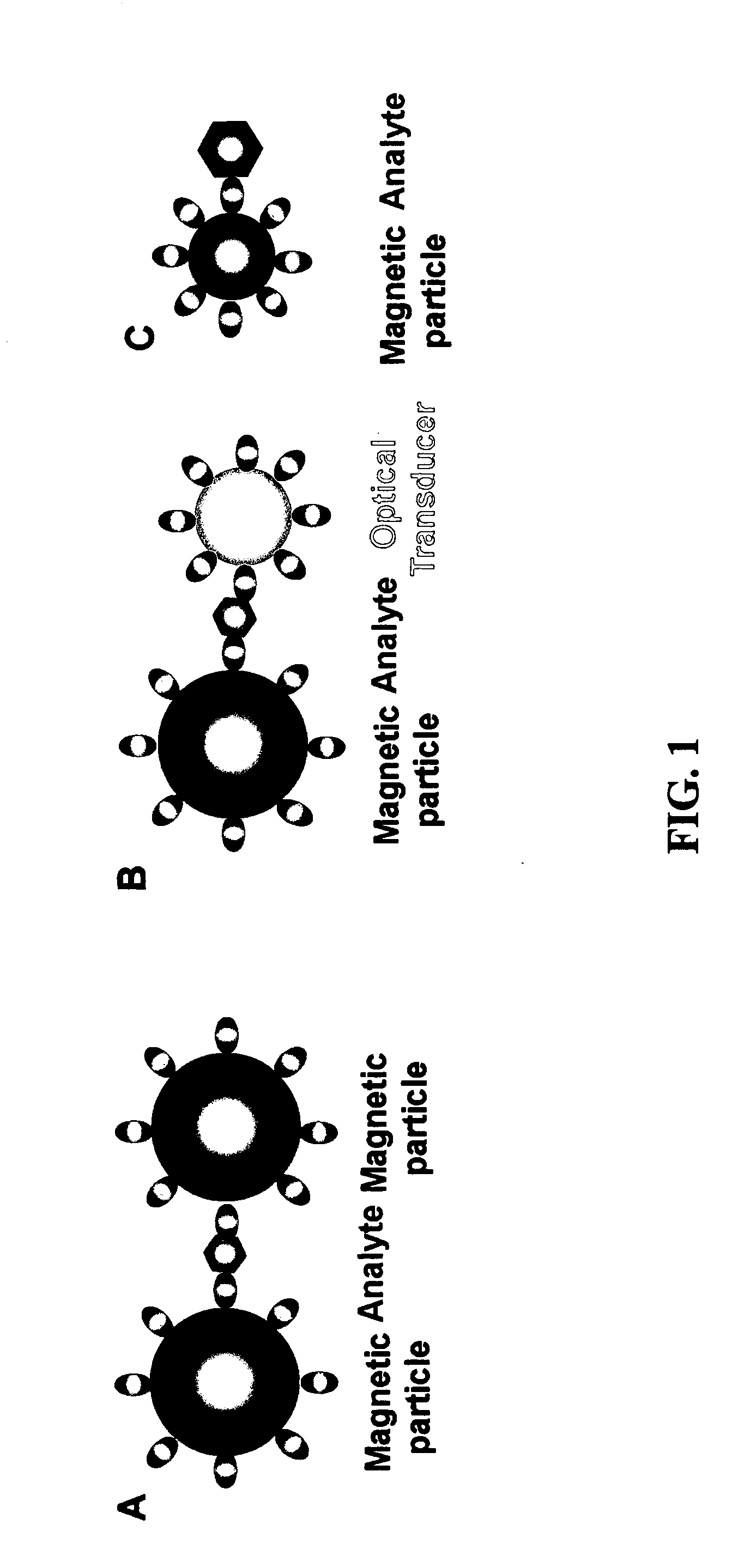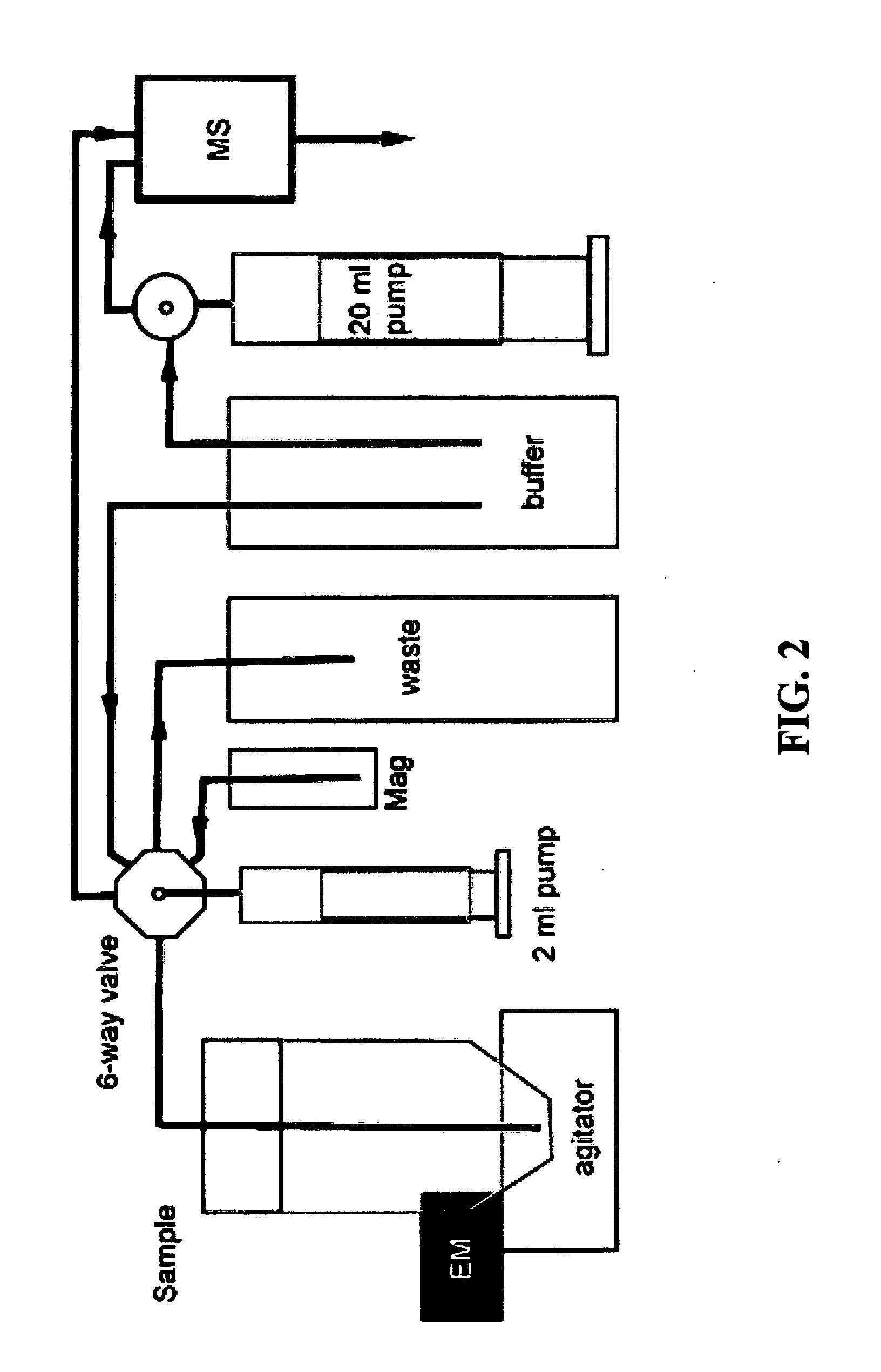Nonlinear magnetophoretic separation of biological substances
a technology of biological substances and magnetophoretic separation, applied in the field of biological separation methods and materials, can solve the problems of difficult treatment, limited technology use, and typical slowness, and achieve the effect of high-sensitivity separation of magnetic beads
- Summary
- Abstract
- Description
- Claims
- Application Information
AI Technical Summary
Benefits of technology
Problems solved by technology
Method used
Image
Examples
example 1
Construction of Micro-Magnet Array
[0053]The micro-magnet arrays were produced by a conventional photolithographic liftoff process. This technique was used to fabricate 5-μm diameter, 70 nm thick cobalt micro-magnets that were equally spaced in a square array with center to center distance of 8 μm. These magnets were coated with a micron thick layer of spin-on glass. The glass layer was then coated with a layer of casein, which is a milk protein, to minimize the adhesion of the microparticles with the spin-on glass layer.
[0054]Calculations suggest that the thickness of the spin-on glass layer is not optimized at one micron. Further refinement of the thickness of the layer is within the skill of the practitioner. A further consideration is the type of coating applied to the glass layer. The coating must be one that does not adhere to the magnetic particles, neither those particles bearing a target analyte or those free of analyte. Other coatings for the micro-magnets can include hydro...
example 2
Construction of Magnetophoretic Instrument
[0055]The rotating field was produced by two pairs of air-core solenoids fitted with cast iron cores, which were arranged along mutually orthogonal axes (x-z) with respect to the wafer surface. Two current sources controlled by Labview software (National Instruments, Austin, Tex.) were used to supply sinusoidal waveforms to each pair of solenoid coils, adjusted with 90° phase difference in order to generate rotating magnetic field. Magnetic beads were injected onto the wafer surface in a 10-μm thick fluid layer, and the separation process was observed through a Leica DMLM microscope in a 40× or 100× objective.
example 3
Microparticles and Surface Chemistries
[0056]MyOne™ and M-270™ superparamagnetic beads were purchased from Dynal Biotech (Madison, Wis.) due to the uniformity of the particle size. These beads are reported to be loaded with 37% and 20% ferrites by volume, respectively. The beads were acquired with carboxyl or streptavidin surface coatings. The B. globigii and polyclonal antibodies against B. globigii were a kind gift of Jennifer Aldrich and Thomas O'Brien (Tetracore, LLC, Rockville, Md.). These antibodies were biotinylated by reaction in a 1:20 molar ratio with sulfosuccinimidobiotin (Pierce, Rockford, Ill.) in a 12 mM phosphate buffered saline, 150 mM NaCl, pH 7.4, for 30 minutes. Excess biotin was removed by passing the solution through cellulose desalting column (Pierce). The S. cerevisiae (i.e. baker's yeast) was obtained from Sigma-Aldrich (St. Louis, Mo.) and the biotinylated concanavalin A (con A) was obtained from Biomeda (Foster City, Calif.). The 1-μm streptavidin functiona...
PUM
 Login to View More
Login to View More Abstract
Description
Claims
Application Information
 Login to View More
Login to View More - R&D
- Intellectual Property
- Life Sciences
- Materials
- Tech Scout
- Unparalleled Data Quality
- Higher Quality Content
- 60% Fewer Hallucinations
Browse by: Latest US Patents, China's latest patents, Technical Efficacy Thesaurus, Application Domain, Technology Topic, Popular Technical Reports.
© 2025 PatSnap. All rights reserved.Legal|Privacy policy|Modern Slavery Act Transparency Statement|Sitemap|About US| Contact US: help@patsnap.com



